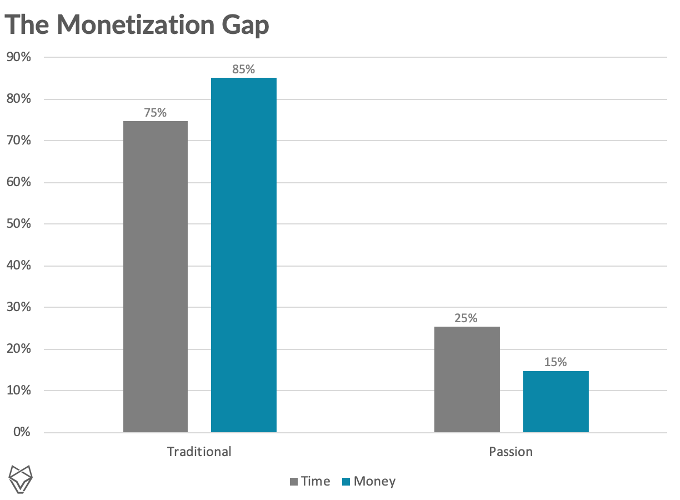In an effort to quantify the opportunity for creators participating in the passion economy, we attempted to measure the apparent imbalance of value that flows to creators relative to the amount of time we spend consuming their content. After a simple exercise of assessing the time we spend consuming professionally created media (traditional) vs. individually created media (passion) and the advertising dollars that flow to the given mediums, we found…
- We spend 25% of our media-consuming time with passion media, but only 15% of total media advertising dollars flow to it.
- Conversely, we spend 75% of our time with traditional media, and it commands 85% of the ad dollars.
This imbalance represents an opportunity for creators, but its surprisingly small magnitude ultimately highlights the fact that the real opportunity for individual monetization lies in direct subscriptions and delivering unique services, rather than competing solely for attention and advertising dollars.
Background
In our first piece related to the passion economy, we introduced the idea of new tools and business models which allow individuals to bypass the institutions that once controlled the production and distribution of content, leading to ever-smaller niches being filled by the best creators, and more relevant and meaningful content being delivered to consumers. We believe these converging trends will reshape how we work and what we consume in the following decades.
Today, the most visible participants of the passion economy are individual stars that have captivated audiences through distribution platforms such as Instagram, YouTube, TikTok, and others. Influencers, as they may be called, extract value by capturing their audience’s attention, which is then monetized through advertising. Other individuals elect to monetize themselves by providing a unique service and transacting directly with their audience, which we will break down in a later note.
Based on our understanding of consumer behavior and the media value chain, the hypothesis was that individual content creators were essentially undervalued with respect to the attention they receive. If we divide the media landscape between professionally produced content (think NBC) and individually produced content (think a vlog on YouTube), we seem to be spending more and more time with individual creators, but advertisers (monetizers of attention) have not caught up with this behavior.
Importantly, this trend is even more pronounced among young people, with their consumption skewing even further toward passion media. As this cohort grows up and purchasing power shifts, we expect passion economy creators to be more and more undervalued by advertisers.
The culmination of this exercise is the chart below that shows traditional media as slightly over-monetized and passion media as slightly under-monetized. The implication here is that individual creators will continue to win more of our attention, and advertisers will shift their spending from television, radio, and print media, to things like YouTube, podcasts, and social media. We’ve seen the gap between attention and dollars close before – cable television in the ’60s, early adopters of the internet in the ’00s, mobile web several years later, and gaming underway today. If this pattern plays out again, creators have a material opportunity in capturing their audience’s attention.

How did we arrive here?
As a simple methodology, we calculated the average time (hours per day) each American spends with ad-supported media (radio, television, podcasts, newspapers, Instagram, etc.) and the annual US advertising market for each of them. Sources for these numbers can be found here. We then broke down each medium into traditional and passion media. Television, for example, is all professional content, TikTok is all passion content, and YouTube has a mix of both. For mixed mediums, we assigned a traditional/passion factor based on a sample of 100 pieces of content on each platform.
This yielded a total addressable advertising market of $151B, of which $128.3B (85%) flows to traditional media and $22.4B (15%) to passion media. Of the 8.5 hours per day we spend with media, 6.3 (75%) of them are with traditional media and 2.2 (25%) are with passion media. Notably, this excludes subscription media platforms like Spotify and Netflix.
Why it might be different this time
As a mental exercise, imagine advertisers recognized this shift and allocated their spending right in line with where consumers spend their time, taking 10% from the over-monetized traditional media and adding it to passion media. $15.5B new ad dollars are essentially up for grabs for creators, and at $100k per person, that means 155k new creators can earn a living. However, this number needs to be adjusted. Most of it will flow through distribution platforms that take a cut – YouTube takes 45% for example. It also doesn’t account for the fact that many platforms pay out a majority of their ad revenue to the top 1% of creators. Adjusting for a 45% take rate and paying half to the top 1% leaves just $4.3B up for grabs, or enough to support 43k new creators.
When put that way, closing the monetization gap for creators looks admittedly less enticing than we had imagined. However, the inverse takeaway (the gap is smaller than we thought) may actually point to a different, bigger opportunity if you still believe in the passion economy.
Measuring the narrowing gap between eyeballs and dollars was previously (cable TV, internet, mobile web, gaming) based on the idea that, in the eyes of advertisers, time is money, and the two will eventually equal each other – a very attention economy way of thinking. However, digital ads weren’t the most valuable creation of the web, it was the countless second-order effects like new services that became possible. Similarly, the passion economy won’t be defined by vloggers making 55% of their YouTube ad revenue; its real contribution will be the knock-on effects of the very best individuals performing services for which they are uniquely suited.
So while the opportunity for creators to be valued based on the attention they receive may be closer to correctly estimated than underestimated, that should not undermine the passion economy overall. The real opportunity lies in a different monetization method altogether. One of the core tenants of the passion economy is the direct relationship between creator and audience, cutting out gatekeepers and allowing for direct communication and transactions. This usually takes the form of a monthly or annual subscription that is paid in exchange for receiving a service, not just being entertained and paying indirectly with your time and attention.
New platforms are extending the range of services that individuals are able to provide in place of companies. Outschool competes with traditional education, Substack competes with major publications, and Playbook competes with pro personal trainers. Creators will capture more than just our attention, they will slowly infiltrate various pockets of personal and household spending, stealing share from existing companies or creating consumption where there was previously none.
Next, we plan to dig into the spending categories that are addressable by individual creators to better size up the market outside of advertising that is up for grabs in the passion economy.
